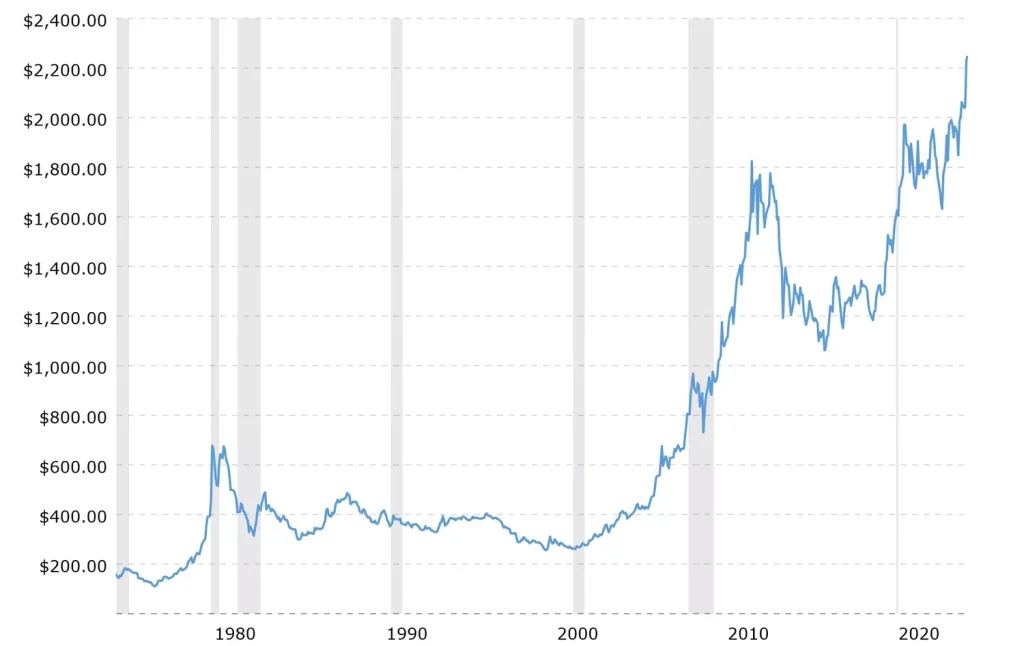The History and Evolution of Gold IRAs
Introduction
In recent decades, Gold Individual Retirement Accounts (IRAs) have gained significant traction among investors looking to diversify their retirement portfolios. Gold IRAs offer the benefits of physical gold ownership combined with the tax advantages of an IRA. This article explores the history and evolution of Gold IRAs, highlighting their origins, key milestones, and current trends.
Early Beginnings: The Foundation of IRAs
The concept of IRAs was introduced in 1974 with the Employee Retirement Income Security Act (ERISA). This act was designed to provide employees with more secure retirement options. Traditional IRAs initially allowed investments in stocks, bonds, and mutual funds, but not physical assets like gold.

The 1997 Taxpayer Relief Act
A pivotal moment in the history of Gold IRAs came with the Taxpayer Relief Act of 1997. This legislation expanded the investment options for IRAs, allowing for the inclusion of certain types of physical gold, silver, platinum, and palladium. The act specified the purity standards that these metals must meet to be eligible for inclusion in an IRA:
- Gold: 99.5% pure
- Silver: 99.9% pure
- Platinum and Palladium: 99.95% pure
Growth in Popularity: 2000s and Beyond
The early 2000s saw a surge in the popularity of Gold IRAs, driven by rising gold prices and increasing market volatility. Investors began to see gold as a hedge against inflation and economic uncertainty. The 2008 financial crisis further bolstered gold’s reputation as a stable investment, leading to a significant increase in the number of Gold IRA accounts.

The Role of Custodians and Dealers
To comply with IRS regulations, Gold IRAs must be managed by a custodian and the physical gold stored in an approved depository. Custodians are responsible for the administration of the account, while dealers facilitate the purchase and sale of gold. This dual role ensures that investments are handled professionally and securely.
Recent Developments and Trends
In recent years, there has been a growing trend towards self-directed IRAs, allowing investors more control over their assets, including precious metals. Technological advancements have made it easier to manage and track Gold IRAs, increasing their accessibility to a broader audience.
Benefits of Gold IRAs
- Diversification: Gold IRAs provide a hedge against market volatility and inflation.
- Security: Physical gold is a tangible asset with intrinsic value.
- Tax Advantages: Like other IRAs, Gold IRAs offer various tax benefits.
Challenges and Considerations
While Gold IRAs offer numerous benefits, they also come with challenges such as higher fees for storage and insurance, and the potential for fluctuating gold prices. It’s crucial for investors to conduct thorough research and consult with financial advisors before committing to a Gold IRA.
Gold IRAs have evolved significantly since their inception, offering investors a valuable tool for securing their retirement savings. By understanding the history and nuances of Gold IRAs, investors can make informed decisions to protect and grow their wealth.
The Role of Gold in Economic Stability
Gold has long been regarded as a stable investment, particularly during times of economic downturn. This perception is rooted in several historical and economic factors that have consistently demonstrated gold’s ability to retain value and even appreciate when other asset classes falter. Here’s a closer look at how gold has historically contributed to economic stability:
Historical Context
Ancient Times to the Gold Standard: Gold has been used as a form of currency and store of value for thousands of years. Ancient civilizations, from the Egyptians to the Romans, valued gold for its rarity and durability. In more modern history, the gold standard, which was widely used in the 19th and early 20th centuries, pegged the value of a country’s currency directly to a specific amount of gold. This system provided a stable monetary base and helped control inflation and stabilize economies.
Great Depression (1929-1939): During the Great Depression, gold prices were relatively stable compared to other assets. The U.S. government even increased the price of gold from $20.67 to $35 per ounce in 1934 to stimulate the economy, demonstrating gold’s perceived value as a secure asset during times of crisis (Investopedia).
1970s Inflation: The 1970s saw significant inflation in the United States, partly due to the abandonment of the gold standard in 1971. During this period, gold prices surged as investors sought refuge from the declining purchasing power of the dollar. By the end of the decade, gold prices had increased from about $35 per ounce to over $600 per ounce (Money).
Economic Stability and Modern Times
2008 Financial Crisis: The global financial crisis of 2008 was a period of severe economic turmoil, with widespread losses in stock markets and real estate. During this time, gold prices soared as investors fled to the safety of precious metals. From 2007 to 2011, gold prices nearly tripled, reflecting its role as a safe-haven asset during economic instability (Benzinga) (Finbold).
COVID-19 Pandemic: The COVID-19 pandemic caused unprecedented economic disruptions worldwide. As markets plummeted and uncertainty rose, gold once again proved its value. In 2020, gold prices hit an all-time high of over $2,000 per ounce, highlighting its ongoing relevance as a protective asset against economic volatility (Benzinga).

Why Gold Remains a Stable Investment
Intrinsic Value: Unlike paper currency, gold has intrinsic value due to its physical properties and limited supply. This intrinsic value provides a hedge against inflation and currency devaluation.
Diversification: Gold is often used to diversify investment portfolios. Its price tends to move independently of other assets like stocks and bonds, reducing overall portfolio risk during economic downturns.
Safe-Haven Asset: During periods of geopolitical instability or financial crisis, investors flock to gold as a safe haven. This behavior reinforces gold’s stability and often drives up its price when other assets are declining.
Liquidity: Gold is highly liquid, meaning it can be easily bought and sold on the global market. This liquidity ensures that investors can readily convert gold into cash when needed, providing financial stability during crises.
Gold’s historical performance during economic downturns and its inherent qualities make it a reliable and stable investment. Whether used as a hedge against inflation, a tool for diversification, or a safe-haven asset, gold continues to play a crucial role in maintaining economic stability for investors worldwide.
Differences Between Gold IRAs and Traditional IRAs
Individual Retirement Accounts (IRAs) are popular tools for retirement savings in the United States. Among the various types of IRAs, Gold IRAs and Traditional IRAs are two options that cater to different investment strategies and preferences. This article highlights the key differences between these two types of IRAs and explores the benefits of each.
What is a Gold IRA?
A Gold IRA is a self-directed IRA that allows investors to hold physical gold and other precious metals as part of their retirement portfolio. These IRAs offer the same tax advantages as traditional IRAs but provide an alternative to holding paper assets like stocks and bonds.
What is a Traditional IRA?
A Traditional IRA is a retirement savings account that allows individuals to contribute pre-tax income, which can grow tax-deferred until withdrawal. Investments typically include stocks, bonds, mutual funds, and other paper assets.
Key Differences
Investment Options
- Gold IRA: Allows investments in physical gold, silver, platinum, and palladium. These metals must meet specific purity standards set by the IRS.
- Traditional IRA: Typically includes stocks, bonds, mutual funds, ETFs, and other paper assets. Physical precious metals are generally not included.
Custodianship
- Gold IRA: Requires a custodian who specializes in self-directed IRAs and is equipped to handle physical precious metals. The metals must be stored in an IRS-approved depository.
- Traditional IRA: Managed by traditional financial institutions like banks, brokerage firms, or mutual fund companies. The assets are usually held electronically.
Diversification
- Gold IRA: Offers diversification through physical assets, which can hedge against inflation and economic instability.
- Traditional IRA: Provides diversification through a mix of various paper assets but does not include physical commodities.
Risk and Volatility
- Gold IRA: Gold and other precious metals can be more stable during economic downturns, serving as a hedge against market volatility.
- Traditional IRA: Paper assets like stocks and bonds can be more volatile and susceptible to market fluctuations.
Fees and Costs
- Gold IRA: Typically involves higher fees, including setup fees, storage fees, and custodian fees for managing physical assets.
- Traditional IRA: Generally has lower fees associated with account management and transactions but may include trading fees and fund management fees.
Liquidity
- Gold IRA: Physical gold can be less liquid than paper assets, as it must be sold and transferred from a depository, which can take time.
- Traditional IRA: Paper assets can be more easily traded and converted to cash, providing greater liquidity.
Benefits of Gold IRAs
- Hedge Against Inflation: Gold historically retains its value and can protect against inflation and currency devaluation.
- Economic Stability: Physical gold can provide stability during economic downturns and market volatility.
- Portfolio Diversification: Including gold in a retirement portfolio adds a layer of diversification.
Benefits of Traditional IRAs
- Tax Advantages: Contributions are tax-deductible, and the investment grows tax-deferred until withdrawal.
- Wide Range of Investments: Offers a broad spectrum of investment options, allowing for greater flexibility and growth potential.
- Easier Management: Managed by traditional financial institutions, making it simpler for most investors to handle.

Tax Benefits and Implications of Gold IRAs
Gold Individual Retirement Accounts (IRAs) offer unique opportunities for investors to diversify their retirement portfolios with physical gold and other precious metals. While Gold IRAs provide several tax advantages, they also come with specific tax implications and potential pitfalls. This article explores the tax benefits and possible tax pitfalls associated with Gold IRAs.
Tax Advantages of Gold IRAs
Tax-Deferred Growth
- Traditional Gold IRAs: Contributions to a traditional Gold IRA are made with pre-tax dollars, meaning you can deduct them from your taxable income in the year you make the contribution. The investments grow tax-deferred, meaning you don’t pay taxes on gains until you withdraw the funds during retirement (Investopedia) (Money).
- Roth Gold IRAs: Contributions to a Roth Gold IRA are made with after-tax dollars, so there is no immediate tax deduction. However, the investments grow tax-free, and qualified withdrawals during retirement are also tax-free. This can be particularly beneficial if you expect to be in a higher tax bracket during retirement (Benzinga).
Diversification Benefits
- Including gold in your retirement portfolio can reduce overall risk and volatility. This diversification can help protect your retirement savings from market downturns and inflation, potentially leading to more stable and tax-efficient growth (Finbold).
Rollover and Transfer Benefits
- You can roll over funds from a traditional IRA, 401(k), or other qualified retirement account into a Gold IRA without incurring immediate taxes. This allows you to diversify your retirement savings into physical gold while maintaining the tax-deferred status of your investments (Investopedia).
Potential Tax Pitfalls of Gold IRAs
Early Withdrawal Penalties
- Withdrawals from a traditional Gold IRA before age 59½ are subject to a 10% early withdrawal penalty in addition to ordinary income taxes. Roth Gold IRAs also have penalties for early withdrawals of earnings, although contributions can be withdrawn tax-free at any time (Money).
Required Minimum Distributions (RMDs)
- Starting at age 73, you must begin taking RMDs from a traditional Gold IRA. Failing to take the required amount results in a hefty penalty of 50% of the RMD amount not withdrawn. Roth IRAs do not have RMDs during the account owner’s lifetime, which can provide more flexibility in managing retirement income and taxes (Benzinga).
Storage and Custodian Fees
- Gold IRAs require the physical gold to be stored in an IRS-approved depository, and these storage fees can add up. While these fees are necessary for compliance, they do not provide a tax deduction and can reduce the overall tax efficiency of your investments (Finbold).
Capital Gains Tax on Non-IRA Gold
- If you invest in gold outside of an IRA, selling your gold investments could result in capital gains taxes. Long-term capital gains on gold are taxed at a higher collectibles rate of 28%, which is higher than the standard capital gains tax rate. This makes Gold IRAs more attractive for holding gold investments in a tax-advantaged manner (Investopedia).
Complexity and Compliance
- Gold IRAs are self-directed, meaning you have more control over the investments but also more responsibility. Ensuring compliance with IRS regulations can be complex, and any mistakes could lead to penalties and additional taxes. It is essential to work with a knowledgeable custodian and tax advisor to navigate these complexities (Money).
Comparing Gold IRAs with Other Precious Metals IRAs
Precious Metals IRAs provide an alternative investment option for those looking to diversify their retirement portfolios with tangible assets. While Gold IRAs are the most popular, IRAs can also hold other precious metals like silver, platinum, and palladium. This article compares Gold IRAs with IRAs holding silver, platinum, and palladium, highlighting their unique characteristics, benefits, and potential drawbacks.
Gold IRAs
Gold IRAs involve investing in physical gold, typically in the form of bars or coins, that meet IRS purity standards of 99.5% purity. Gold is often viewed as a hedge against inflation and economic instability due to its historical role as a store of value.
Benefits:
- Stability: Gold has historically maintained its value, especially during economic downturns.
- Hedge Against Inflation: Gold is known for preserving purchasing power during inflationary periods.
- Global Demand: Gold has a consistent demand worldwide, providing liquidity.
Drawbacks:
- Storage and Insurance Costs: Physical gold requires secure storage and insurance, adding to the overall costs.
- No Yield: Gold does not produce income like dividends or interest.
Silver IRAs
Silver IRAs involve investing in physical silver that meets IRS purity standards of 99.9%. Silver is both an industrial and precious metal, making it sensitive to economic and industrial demand.
Benefits:
- Industrial Demand: Silver’s extensive industrial use can drive demand and potentially increase value.
- Affordability: Silver is less expensive per ounce than gold, allowing for more substantial quantities to be purchased for the same investment.
Drawbacks:
- Volatility: Silver prices can be more volatile than gold due to its industrial applications.
- Storage Space: Because silver is less dense than gold, it requires more storage space for the same dollar value.
Platinum IRAs
Platinum IRAs involve investing in physical platinum that meets IRS purity standards of 99.95%. Platinum is primarily used in industrial applications, particularly in the automotive industry for catalytic converters.
Benefits:
- Industrial Demand: High demand from industries, particularly automotive, can drive the value of platinum.
- Rarity: Platinum is rarer than gold and silver, potentially leading to higher value over time.
Drawbacks:
- Market Sensitivity: The price of platinum can be highly sensitive to industrial demand and economic cycles.
- Cost: Platinum is often more expensive than gold, which can be a barrier for some investors.
Palladium IRAs
Palladium IRAs involve investing in physical palladium that meets IRS purity standards of 99.95%. Like platinum, palladium is used extensively in the automotive industry for catalytic converters.
Benefits:
- High Demand: Increasing demand for catalytic converters boosts palladium’s value.
- Strong Performance: Palladium has shown strong price performance in recent years due to supply shortages.
Drawbacks:
- Volatility: Palladium prices can be highly volatile and influenced by changes in industrial demand.
- Limited Market: The market for palladium is smaller and less liquid compared to gold and silver.
Comparative Analysis
Investment Stability
- Gold: Offers the most stability and is considered a safe-haven asset.
- Silver: More volatile but offers higher growth potential due to industrial demand.
- Platinum and Palladium: Highly sensitive to industrial demand, offering potential for high returns but with increased risk.
Cost and Accessibility
- Gold and Platinum: Generally more expensive, which can limit the amount investors can purchase.
- Silver: More affordable, allowing for larger quantities to be held in an IRA.
- Palladium: Prices have been high recently, driven by supply and demand dynamics.
Market Demand and Liquidity
- Gold: High liquidity and global demand ensure ease of buying and selling.
- Silver: Good liquidity with significant industrial and investment demand.
- Platinum and Palladium: Less liquid but in strong demand for specific industrial uses.
Choosing between Gold IRAs and other Precious Metals IRAs depends on individual investment goals, risk tolerance, and market outlook. Gold provides stability and is a proven hedge against inflation, while silver offers affordability and industrial growth potential. Platinum and palladium present opportunities for high returns but come with increased volatility and market sensitivity. Understanding these differences can help investors make informed decisions to diversify and strengthen their retirement portfolios.
Current Market Trends Affecting Gold IRAs
Gold IRAs continue to be a popular investment choice for those looking to diversify their retirement portfolios and hedge against economic uncertainties. Various current economic and market trends impact the value and attractiveness of Gold IRAs. This article analyzes these trends, providing insights into how they influence gold investments.
1. Inflation and Monetary Policy
Trend: Persistent inflation and changing monetary policies significantly affect gold prices and Gold IRAs.
Analysis:
- Inflation erodes the purchasing power of fiat currencies, leading investors to seek refuge in tangible assets like gold. As inflation rates remain high, the demand for gold typically increases, driving up its price (Investopedia).
- Central banks’ monetary policies, such as interest rate adjustments, also play a crucial role. For instance, when central banks raise interest rates to combat inflation, it can negatively impact gold prices in the short term due to the increased opportunity cost of holding non-yielding assets like gold. Conversely, low-interest rates can bolster gold prices (Money).
Impact on Gold IRAs: High inflation and accommodative monetary policies tend to enhance the appeal of Gold IRAs, as they provide a hedge against declining currency values and economic instability.
2. Geopolitical Tensions
Trend: Geopolitical uncertainties and conflicts often lead to increased demand for safe-haven assets like gold.
Analysis:
- Events such as trade wars, political unrest, and military conflicts can create economic uncertainty and market volatility. During such times, investors flock to gold as a stable store of value, increasing its price (Benzinga).
- Recent geopolitical tensions, including those in Eastern Europe and the Middle East, have contributed to volatility in global markets, thereby boosting the demand for gold.
Impact on Gold IRAs: Gold IRAs benefit from geopolitical tensions as they drive investors towards safe-haven assets, resulting in higher gold prices and increased demand for gold investments.
3. Economic Recovery Post-Pandemic
Trend: The global economic recovery from the COVID-19 pandemic has mixed effects on gold prices.
Analysis:
- Economic recovery can lead to increased consumer spending and investment in riskier assets like stocks, potentially reducing the demand for gold. However, the pace and stability of the recovery vary across regions, leading to uncertainty and sustained interest in gold as a hedge (Finbold).
- Supply chain disruptions and varying recovery speeds can maintain inflationary pressures, supporting gold prices as a protective measure against economic instability.
Impact on Gold IRAs: The uneven economic recovery and persistent uncertainties maintain gold’s appeal as a safe-haven asset, supporting its inclusion in retirement portfolios through Gold IRAs.
4. Technological and Industrial Demand
Trend: Advances in technology and increased industrial use of gold and other precious metals impact their market dynamics.
Analysis:
- Gold is not only a financial asset but also has significant industrial applications, particularly in electronics and technology. Rising demand for these applications can support gold prices.
- Other precious metals like silver, platinum, and palladium also see increased demand due to their industrial uses in technology and green energy solutions, influencing their prices and attractiveness as IRA investments (Investopedia) (Money).
Impact on Gold IRAs: The dual role of gold as both an investment and an industrial commodity can provide additional support to its value, making Gold IRAs a resilient choice for diversifying retirement portfolios.
5. Currency Fluctuations
Trend: Fluctuations in currency values, particularly the US dollar, have a direct impact on gold prices.
Analysis:
- Gold is typically priced in US dollars, so a weaker dollar makes gold cheaper and more attractive to investors using other currencies, driving up demand and prices.
- Conversely, a stronger dollar can make gold more expensive and less appealing, potentially lowering demand and prices.
Impact on Gold IRAs: Investors need to monitor currency trends as part of their Gold IRA strategy, as shifts in the dollar’s strength can affect the value of their investments.
The Future Outlook for Gold IRA Investments
Gold IRAs have long been considered a valuable component of diversified retirement portfolios. As we look to the future, several key factors and trends suggest that gold will continue to play an important role in retirement planning. This article provides insights into the future prospects of gold as an investment for retirement, supported by various economic, geopolitical, and market analyses.
1. Economic Uncertainty and Inflation
Insights:
- Persistent Inflation: Inflationary pressures remain a concern globally, driven by factors such as supply chain disruptions, increased consumer demand, and expansive monetary policies. Gold is historically viewed as a hedge against inflation, making Gold IRAs attractive during periods of rising prices (Investopedia) (Money).
- Economic Volatility: Ongoing economic uncertainty, including potential recessions and financial crises, can enhance gold’s appeal as a safe-haven asset. Investors often turn to gold during market turmoil to protect their wealth (Benzinga).
Future Impact: As inflation and economic volatility persist, the demand for gold is likely to remain strong, supporting the value of Gold IRAs.
2. Geopolitical Risks
Insights:
- Geopolitical Tensions: Geopolitical events, such as conflicts, trade disputes, and political instability, can significantly impact global markets. Gold tends to perform well during times of geopolitical uncertainty as investors seek stability (Money) (Benzinga).
- Safe-Haven Demand: The safe-haven status of gold means that any increase in geopolitical risks can drive up demand for gold investments, including Gold IRAs.
Future Impact: Geopolitical risks are expected to persist, potentially leading to sustained or increased demand for gold as a protective investment.
3. Technological Advancements and Industrial Demand
Insights:
- Technological Use: Advances in technology and the growing use of gold in electronics, medical devices, and other high-tech applications can boost demand for gold. This industrial demand can provide additional support for gold prices (Investopedia) (Finbold).
- Green Technologies: The shift towards green technologies, including renewable energy and electric vehicles, increases the demand for certain precious metals, including gold, due to its conductive properties and use in advanced technologies (Money).
Future Impact: Continued technological advancements and the adoption of green technologies can bolster the demand for gold, positively influencing Gold IRA investments.
4. Central Bank Policies and Currency Fluctuations
Insights:
- Central Bank Buying: Central banks around the world have been increasing their gold reserves as a means of diversifying their holdings and protecting against currency devaluation. This trend is likely to continue, providing strong support for gold prices (Finbold).
- Currency Fluctuations: The value of major currencies, particularly the US dollar, can impact gold prices. A weaker dollar tends to make gold more attractive, potentially driving up its price and benefiting Gold IRAs (Money).
Future Impact: Central bank policies and currency fluctuations will continue to play a significant role in the gold market, influencing the attractiveness and value of Gold IRAs.
5. Investment Diversification and Portfolio Strategy
Insights:
- Diversification Benefits: As investors seek to diversify their portfolios to manage risk, gold remains a key component due to its low correlation with other asset classes. This diversification can help stabilize portfolio returns, especially during market downturns (Benzinga) (Finbold).
- Long-Term Stability: Gold’s historical performance as a store of value and hedge against economic uncertainty makes it a reliable long-term investment for retirement portfolios.
Future Impact: The ongoing need for diversification and long-term stability in retirement portfolios will support the continued inclusion of Gold IRAs in investment strategies.
Common Myths and Misconceptions About Gold IRAs
Investing in Gold IRAs can be a valuable strategy for diversifying retirement portfolios, but several myths and misconceptions often deter potential investors. This article aims to debunk these myths and provide factual information about Gold IRAs.
Myth 1: Gold IRAs Are Only for the Wealthy
Debunking the Myth:
- Reality: Gold IRAs are accessible to a wide range of investors. While gold has historically been associated with wealth, modern financial services have made it easier for average investors to include gold in their retirement portfolios. Many custodians offer Gold IRAs with relatively low minimum investment requirements, making them accessible to more people (Investopedia) (Money).
Myth 2: Gold IRAs Do Not Offer Tax Advantages
Debunking the Myth:
- Reality: Gold IRAs provide the same tax benefits as traditional IRAs. Contributions to a traditional Gold IRA are tax-deferred, meaning you do not pay taxes on the contributions or earnings until you withdraw the funds in retirement. Roth Gold IRAs offer tax-free withdrawals, as contributions are made with after-tax dollars (Benzinga).
Myth 3: Physical Gold Is Not Allowed in IRAs
Debunking the Myth:
- Reality: Physical gold is indeed allowed in IRAs, provided it meets certain purity standards set by the IRS. Approved forms include specific gold bullion bars and coins. The IRS has strict guidelines on the types of gold that can be included, ensuring that only high-quality metals are used in Gold IRAs (Finbold).
Myth 4: Gold IRAs Are Risk-Free
Debunking the Myth:
- Reality: Like any investment, Gold IRAs come with risks. The value of gold can be volatile and is influenced by various economic factors. While gold is often seen as a stable investment, it does not guarantee returns and can experience price fluctuations. It’s essential for investors to understand these risks and diversify their portfolios accordingly (Money).
Myth 5: Setting Up a Gold IRA Is Complicated
Debunking the Myth:
- Reality: While setting up a Gold IRA involves specific steps and regulations, it is not overly complicated, especially with the help of a reputable custodian. Many custodians offer comprehensive services to guide investors through the process, including the purchase and storage of gold (Investopedia).
Myth 6: You Can Store Gold IRA Investments at Home
Debunking the Myth:
- Reality: IRS regulations require that physical gold held in a Gold IRA be stored in an approved depository. Home storage does not meet these requirements and can result in disqualification of the IRA’s tax-advantaged status. Approved depositories ensure that the gold is securely stored and insured (Benzinga) (Finbold).
Myth 7: Gold IRAs Only Hold Gold
Debunking the Myth:
- Reality: While Gold IRAs primarily focus on gold, they can also include other precious metals such as silver, platinum, and palladium, provided they meet IRS purity standards. This allows for further diversification within the precious metals asset class (Money).
Myth 8: Gold IRAs Have Hidden Fees
Debunking the Myth:
- Reality: While Gold IRAs do have fees, reputable custodians are transparent about the costs involved, which can include setup fees, storage fees, and custodian fees. It’s crucial to work with a reputable custodian and fully understand the fee structure before investing (Finbold).
Myth 9: Gold IRAs Are a Short-Term Investment
Debunking the Myth:
- Reality: Gold IRAs are typically intended for long-term investment as part of a diversified retirement strategy. Gold can act as a hedge against inflation and economic instability over the long term, making it a valuable component of a retirement portfolio (Investopedia).
Myth 10: All Gold IRA Custodians Are the Same
Debunking the Myth:
- Reality: Not all custodians are the same, and it’s important to choose one that is experienced and reputable. Different custodians offer varying levels of service, fees, and expertise in handling Gold IRAs. Conducting thorough research and reading reviews can help investors find a trustworthy custodian (Benzinga).
That is why I made my site - Stock Maven. Now that I feel settled and confident about trading, I want to be a source of help to anyone else who might be struggling to break into the crypto market successfully.
My website is full of my tips and tricks, as well as information that I have always found interesting about crypto. My friends and family are sick of hearing me talk about it, so now it’s your turn!
I hope that you stick around and find something useful on my site. Remember, to make it big in crypto, you’ve got to be confident! Go for it and don’t look back.
- How to secure crypto accounts the simple and safe way? - December 24, 2025
- Best crypto apps for beginners in 2026 - December 24, 2025
- Crypto volatility explained: why prices move so fast? - December 24, 2025



